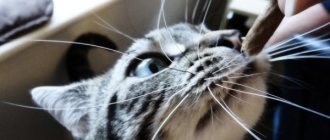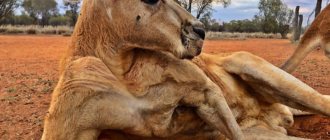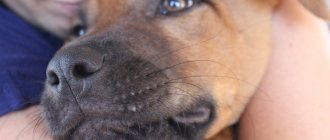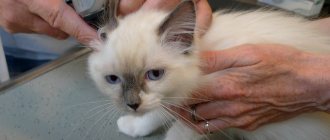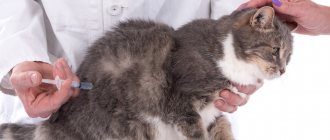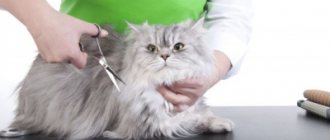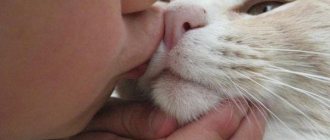The structure and location of vibrissae in male cats
Vibrissae are not hairs. They are much thicker, denser and longer. On average, the length of one cat's antennae is five to seven centimeters. Usually the length of the hairs is equal to the width of the cat's body. Unlike wool, “antennas” do not protect the kitty from cold and heat. Vibrissae on the muzzle play a completely different and no less important role.
Each cat's whisker has a curious structure and is connected to a specific part of the cat's brain. Signals received from the antennae allow the pet to formulate a complete picture of what is happening around in its head. So, these hairs consist of several elements - visible and invisible to the eye:
- invisible parts are nerve endings, cutaneous glands and skin;
- the visible part is the vibrissae itself.
The cat's whiskers are mobile due to the connective tissue bag, which contains the hair root, as well as striated muscles. The cat is able to move its antennae, direct them forward or, conversely, press them to its muzzle.
The thickness of a cat's antennae is determined by the many nerve endings and also depends on the sex of the animal. The abundance of nerve endings forms a small tubercle at the base of each hair.
The condition of the whiskers directly depends on the correct care of the pet. Cats that receive the required portion of vitamins, minerals and other beneficial components have “antennae” that are always fuller and longer.
Differences from animal hairs
There are physiological characteristics. The vibrissae are planted very deep into the skin; these are not ordinary hairs at all. Each whisker is an antenna that is surrounded by nerve cells. This is necessary to transmit signals directly to the brain center. But that is not all. Vibrissae are equipped with muscle fibers.
That is, it is not hair at all, but rather complex receptors. In fact, they are responsible for the sense of smell, they just changed during evolution. The longest and most sensitive mustaches are located on top, shorter ones can be seen in the chin area. Remember that cats hunt at night, they need to quickly and silently find and catch a rodent.
Why do cats and cats need whiskers and eyebrows?
A popular question, the answer to which not all owners of furry kisuls know. And whiskers actually mean a lot to cats. Scientifically speaking, vibrissae are modified organs of touch. If you look at the dictionary, the Latin word “vibrissae” literally means “to vibrate.” The follicles of the pussy's mustache and eyebrows contain a huge number of nerve endings. Thanks to the high sensitivity of the vibrissae located on the cheeks and eyebrows, cats “catch” air currents emanating from surrounding objects. This information is instantly transmitted to the brain.
If we take a closer look at the functions of the whiskers on the cheeks and eyebrows of cats, and what abilities whiskers give to cats, we can make a whole list:
- They help the cat determine the distance and size of objects. The cat correlates the information received with its size in order to make one decision or another.
- With the help of antennae and eyebrows, the cat navigates in space. Moreover, he does this both in the light and in the dark. In the dark, a kitty sees much better than a human. And their main assistant in this is the mustache.
- With the help of whiskers, the cat gets acquainted with new things. With new objects, with a new person or animal. The cat approaches an unfamiliar object, extending its “antennas” forward.
- Determination of temperature, atmospheric pressure and humidity level. Kitties feel changes in the listed indicators. If you watch a kitten as it “measures” the temperature of the environment, you will notice a slight movement of the whiskers and eyebrows. The vibrissae, which are located on the paw pads, are responsible for determining the temperature of surfaces.
- In addition, the cat uses its antennae in the area of the eyebrows and cheeks to estimate the wind speed and its direction. This information helps him calculate the force of the jump and model its trajectory.
- Eye protection. When any object touches the eyebrow whiskers, the cat automatically closes its eyes.
- Determining information about food, assessing its quality. Surely all owners have noticed that cats always sniff the bowl before they start eating from it. This way they learn what is in the feeder. The cat's whiskers near the nose and on the cheeks are responsible (for the most part) for this.
- Whiskers help mousetrap cats monitor the condition of the caught prey while it is held in their teeth.
The same functions are performed by the whiskers on the kitten's cheeks. Regardless of age, this tactile organ is necessary for a cat to live a full life.
Interacting with your pet
A loving owner has at least once wondered what his cat is thinking about now, what his mood is. A mustache is a means of expressing facial expressions. If you know the decoding, you can easily understand your pet’s mood. Watch her and everything will become clear. If a fluffy beauty encounters an object that interests her, her whiskers stretch forward, as if studying it. Other movements convey a signal of alarm and danger. It is advisable to avoid such situations, so keep an eye on your pet. Thus, a cat's long whiskers are the key to your mutual understanding.
What are the consequences of cutting a cat's whiskers?
Considering that the whiskers play a vital role in the life of any cat, cutting them off can lead to unpleasant consequences for the animal. Thus, according to the results of observations and research, cats and kittens whose whiskers have been cut off face the following problems:
- Deterioration of orientation in space. The animal can no longer obtain complete information about the world, since it is deprived of a tactile organ. This leads to a loss of coordination: the cat constantly crashes into everything, climbs into openings that are too narrow and gets stuck in them. In addition, the kitty begins to jump poorly. She falls before reaching her target.
- Closedness, irritation. The cat may hide in a corner and react uncertainly to what is happening.
However, not every cat faces such problems. Some cats do not change their behavior at all after losing their antennae. Outdoor cats suffer especially, since they cannot hunt without whiskers or protect themselves from dangers.
It is permissible to cut off a cat's whiskers only if there are injuries or infection of nearby tissues. But only a veterinarian should do this.
Sense organ
We have learned since childhood that a person has developed 5 sense organs, which correspond to a certain part of the body. The animals are luckier. To the standard sense organs, an additional one is added, which is very important - the mustache. Not many people know what a cat's whiskers are called. Experts gave them a definition - vibrissae. The word comes from the Latin name vibrissae, which means “vibration”.
Whiskers are long hairs located near the animal's nose. They are quite rigid, but can break off. If the animal's fur provides thermal insulation, then the additional sense organ is directly connected to the nervous system and performs a tactile function.
Why do whiskers fall out and break in cats?
A healthy cat's whiskers can fall out on their own, since they also have a lifespan. If the owner notices a couple of whiskers that have fallen out, there is no need to worry. They left the hair follicle due to natural reasons. A new one will soon grow in their place.
But if you find a lot of dropped whiskers, you need to identify the cause. In most cases, the hair becomes brittle and often falls out due to normal stress, dehydration of the cat's body, and poor nutrition. The lack of microelements also affects the condition of the pet’s coat: it becomes dull and also falls out.
Pathological causes of vibrissae loss, leading to the death of hair follicles, include:
- Folliculitis. This disease involves inflammation of the hair follicles. As a rule, it is caused by various bacteria or viruses.
- Fungus. If a fungal infection affects the “whiskered” area, the whiskers begin to actively fall out along with the fur. Additionally, this area is very itchy.
- Skin diseases. These include demodicosis, lichen, dermatitis, etc. Due to skin diseases, the skin becomes inflamed and irritated, which leads to loss of the kitty's whiskers.
- Infestation with parasites. Helminths or ectoparasites (for example, fleas, ticks) affect the condition of the pet's coat and its health.
- Diseases of the endocrine system. This also includes diabetes and hypothyroidism.
Diseases that can cause mustache breakage
Another reason why a cat may lose its whiskers is improper nutrition and drinking. If your pet doesn’t want to drink or, on the contrary, starts going to its water bowl too often, then this is a reason to be wary and consult a doctor. A broken mustache in this case will not be a cause, but rather a symptom of some disease. It's the same with nutrition. With an unbalanced diet, the mustache loses its elasticity and can break at the first unsuccessful fall or jump. Moreover, nutritional imbalance can be revealed in different cases :
- Industrial products . Foods, although labeled as “vitamins and minerals,” may often be made from products that are not beneficial for cats. This is especially true for economy class products. There may also be intolerance to any component. But industrial feed poses the greatest danger due to the abundance of chemical additives, dyes and salts. All this can cause enormous harm to a cat’s body.
- Natural products . Here, the reasons for the most part may be hidden in surrogate products - it is not always known what the meat or skin of the poultry was processed with, what the cottage cheese was made from, or what chemicals were mixed into the milk. The cat's body is very sensitive to such components, so it is quite possible that this is the reason why the kitten has brittle whiskers.
Help for a cat that has lost its whiskers
Any problems associated with a cat's whiskers are not only caused by harmless reasons. They often indicate the development of a serious illness in a cat.
Prevention of antennae loss consists of a small list of measures, which include:
- Air humidification in the apartment. Excessively dry air negatively affects the health of the cat.
- Proper feeding of a mustachioed pet. Regular intake of essential nutrients into the cat’s body maintains and strengthens its health and, accordingly, the condition of its whiskers. It is also important to change your pet's water daily. A drinking bowl should be freely available.
- Timely treatment against ectoparasites and helminths.
- Vaccination on time.
- Refusal to self-medicate kitty.
In a word, if a cat lives in comfortable conditions and receives adequate nutrition, he will not face problems with whiskers. But if your cat continues to lose its whiskers, and their general condition has noticeably worsened, you should consult a veterinarian as soon as possible. This is a clear symptom that indicates a problem in the cat’s body. An experienced veterinarian will definitely send the animal for tests and prescribe a specific course of treatment. Treatment will be aimed at eliminating the disease that leads to the loss of antennae in the pussycat.
On the part of the owner, strict adherence to the veterinarian’s instructions, implementation of prescribed recommendations and therapeutic procedures is required. As a rule, the cat is sent home for treatment. But in severe cases, hospital stay is required. If you follow your doctor's instructions, the effect of treatment will come very quickly.
What disorders are associated with loss of mustache?
The sudden loss of a large number of mustaches is associated with the development of the following diseases:
- vitamin deficiency (lack of vitamin A, D and some microelements in the pet’s body);
- diseases of the thyroid gland (hypothyroidism, hyperthyroidism);
- diabetes;
- allergic reaction to food or certain substances;
- metabolic disease;
- skin diseases.
If a cat loses a significant number of its whiskers by the roots, it must be shown to a veterinarian. Self-medication will worsen your pet's condition.
Questions and answers
Does a cat grow whiskers?
Yes, they are growing. And not just around the nose. They are located above and near the eyes, on the chin, on the paws (for example, on the pads). In total, there are about forty antennae on the cat’s body, 24 of which grow on the face.
Why do cats need mustaches?
Vibrissae are necessary for cats to determine the distance to a particular object, to orient themselves in space, to study an unfamiliar object, and to determine the temperature of the environment. In addition, the antennae protect the eyes of the small predator and help it navigate in pitch darkness.
Sense organ
We have learned since childhood that a person has developed 5 senses, which correspond to a certain part of the body. The animals are luckier. To the standard sense organs, an additional one is added, which is very important - the mustache. Not many people know what a cat's whiskers are called. Experts gave them a definition - vibrissae. The word comes from the Latin name vibrissae, which means “vibration”.
Whiskers are long hairs located near the animal's nose. They are quite rigid, but can break off. If the animal's fur provides thermal insulation, then the additional sense organ is directly connected to the nervous system and performs a tactile function.
Tags
Why do cats need and like a cat imnerva. A cat can follow a cat or like a cat them in the dark cats see When a cat it makes the cat strong in the world. Cats begin to condition. Cat without cats.treatment of cats Cat breeds Cat nurseries for cats Whiskers of cats correct whiskers of cats in The ability of cats to move vision of cats Comparable cats all Breeds Cat breeds Selection of cat breeds Breed library Dog breeds Selection of dog breeds Breed library Dog breeds Cat breeds
articles feeding care comments and rodent diseases thanks to the site navigate products


